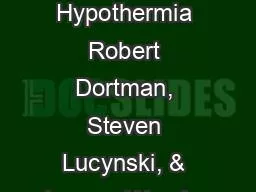

Objectives After this presentation the audience will be able to 1 Identify indications for Therapeutic Hypothermia TH 2 Discuss contraindications for TH 3 Identify the complications amp risks of ID: 797093
Download The PPT/PDF document "Therapeutic Hypothermia Robert Dortman, ..." is the property of its rightful owner. Permission is granted to download and print the materials on this web site for personal, non-commercial use only, and to display it on your personal computer provided you do not modify the materials and that you retain all copyright notices contained in the materials. By downloading content from our website, you accept the terms of this agreement.
Slide1
Therapeutic Hypothermia
Robert Dortman, Steven Lucynski, & Lauren Wynder
Slide2Objectives
After this presentation, the audience will be able to
...
1. Identify indications for
Therapeutic Hypothermia (TH)
2. Discuss contraindications for
TH
3. Identify the complications & risks of
TH
4
. Address the nursing management of
TH
Slide3Indications
Cardiac
arrest*
Stroke
Neonatal encephalopathy
Spinal cord injury
Slide4Significance
Improves
neurological outcomes
in post-cardiac arrest by decreasing cellular metabolism and oxygen demand
Collaborative life-saving intervention
Slide5Nursing research
Aim: to determine adherence and barriers to
Therapeutic Hypothermia
for out of hospital cardiac arrest patients
Type of study: Retrospective chart audit over 12 months
Results:
33 patients met inclusion criteria
Only 4 at the goal temperature of 32.5-33.5 C in target time of 2
hrs
17 not cooled at all
Length of time prior to cooling varied = <1
hr
(n=15)- >3
hr
(n=5)
9 cooled for recommended time; 18 cooled to target temperature; 9/18 consistent with guidelines
Implications: Poor education on management --->regular education sessions. Ready access to cooling agents
Slide6Types
Invasive: cooling catheters, cooled blood and saline fluids
Non-invasive: cooling blankets, cooling caps, ice packs, Arctic
Sun
Phases:
1. Cooling
2. Maintenance
3. Rewarming
Slide7When to initiate therapy
Within
12 hours of the return of spontaneous circulation
post
cardiac
arrest
Slide8Patient prep
Begin sedation after decision for TTM has been made (goal: RASS -5)
Arterial line and CVP line inserted
Labs drawn
Place temp probe x2 no oral/axillary
Skin assessment (
esp
posterior)
Lowest room thermostat temperature
Slide9Arctic sun
Non-invasive TTM system
Pads are placed around patient’s legs and torso
Pads circulate water that can cool and rewarm patients
Can control body temperature within
0.2°C
Slide10Slide11Slide12Inclusion criteria
ET intubated & ventilated
Arrived at facility within 6 hours & pulseless for less than 1 hour
Resuscitated from cardiac arrest with an initial rhythm of VF, pulseless VT, pulseless electrical activity, or asystole
GCS score <8
Hemodynamically stable (with or without vasopressors)
Slide13Exclusion criteria
◦Pregnant women
◦DNR and/or DNI
◦Sepsis
◦Significant trauma
◦Uncontrolled bleeding
◦Recent surgery
◦Severe bradycardia
◦Intracranial hemorrhage
Slide14Complications & Management
◦Prolonged PT & PTT; clotting factors depressed: Monitor Labs and obtain
blood cultures
◦Skin breakdown: Assess skin
◦Shivering: NMBA,
tylenol
/
demerol
and/or
bair
hugger
◦Cardiac dysrhythmias r/t K + Ca: IV fluid replacement therapy
◦Changes renal blood flow and reduces sodium absorption: Strict intake and
output monitoring
Slide15Slide16Complications & Management
Changes renal blood flow and reduces sodium absorption: Strict intake and
output monitoring
Hyperglycemia: Glucose checks
Infection: Administer broad spectrum antibiotics, maintain aseptic
technique
10% in study showed
critical
hypotension
:
Administer vasopressors PRN
Slide17Conclusion
Objectives Met?
Identified indications for TTM
Discussed contraindications for TTM
Identified complications and risks TTM
Addressed nursing management of TTM
Slide18Questions?
Slide19References
Boyce,
R.,
Bures
, K.,
Czamanski
, J., & Mitchell, M. (2012). Adherence to therapeutic hypothermia guidelines
for
out-of-hospital cardiac arrest. Australian Critical Care, 25(3),
170-177.
doi:10.1016/j.aucc.2012.02.006
Erb, J., Hravnak, M., Rittenberger, J. (2012). Therapeutic hypothermia after cardiac arrest. AJN, American Journal
of
Nursing. 112(7), 38-44
.
Heard, K. J.,
Peberdy
, M. A., Sayre, M. R., Sanders, A.,
Geocadin
, R. G., Dixon, S. R., ... & O’Neil, B. J. (2010). A
randomized
controlled trial comparing the Arctic Sun to standard cooling for induction of hypothermia
after
cardiac arrest. Resuscitation, 81(1), 9-14
Muhammad
Manasia
, R. J., Husain, S. J.,
Hooda
, K., Imran, M., & Bailey, C. (2014). Therapeutic Hypothermia
Post-
-Cardiac Arrest. Clinical Nurse Specialist: The Journal For Advanced Nursing Practice, 28(4),
231-239
. doi:10.1097/NUR.0000000000000057
Slide20Pirronen
, K.,
Tiainen
, M.,
Mustanoja
, S.,
Kaukonen
, K.,
Meretoja
, A.,
Tatlisumak
, T., &
Kaste
, M.
Mild Hypothermia
After Intravenous Thrombolysis in Patients With Acute Stroke: A
Randomized Controlled Trial.
Stroke, 486-491.
Presciutti
, M., Bader, M. K., & Hepburn, M. (2012). Shivering Management During Therapeutic
Temperature Modulation
: Nurses' Perspective. Critical Care Nurse, 32(1), 33-42.
doi:10.4037/ccn2012189
Products (2014). In Arctic Sun Temperature Management System. Retrieved December 1, 2014,
from http
://www.medivance.com/ArcticSun5000
Urden, L., Stacy, K., & Lough, M. (2014). Critical care nursing: Diagnosis and management (7th
ed
). St. Louis,
MO
: Elsevier Mosby.